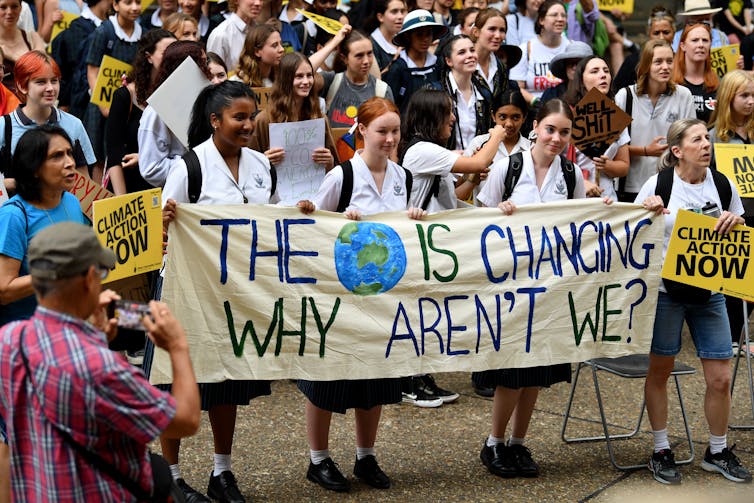Source: The Conversation (Au and NZ) – By Nerilie Abram, Chief Investigator for the ARC Centre of Excellence for Climate Extremes; Deputy Director for the Australian Centre for Excellence in Antarctic Science, Australian National University

Shutterstock
After all the talk on the need for climate action, it’s time for reality check. On Monday the world will receive the latest United Nations climate report. And it’s a big one.
Hundreds of scientists, forming what’s known as the Intergovernmental Panel on Climate Change (IPCC), have been working hard behind the scenes. They’ve produced a series of reports in the latest round, which began in 2015. But on Monday it all comes together in what’s called the Synthesis Report.
It will explain how greenhouse gas emissions are warming the planet, then delve into the consequences. There’s a focus on where we are most vulnerable, as well as efforts to adapt. And then, how we’re acting to reduce emissions and mitigate climate change.
Gathering all the evidence, from every corner of the globe, is an enormous undertaking, let alone reviewing the science to achieve consensus. It’s a process that has been repeated several times since it began, more than three decades ago.
This is the sixth round of reports. And it won’t be the last. But this is a crucial moment, because the chance to limit warming and avert dangerous climate change is slipping away.
Read more:
6 reasons 2023 could be a very good year for climate action
What is the IPCC and why do we need it?
The IPCC is comprised of 195 member countries charged with producing comprehensive and objective assessments of the scientific evidence for climate change.
The World Economic Forum ranks climate action failure as the number-one risk on a global scale over the next decade. And several other top-ten global risks – extreme weather, biodiversity loss, human environment damage and natural resource crises – are made worse by climate change.
Governments, industries and communities are becoming increasingly aware of the need to tackle climate change, especially as predictions become reality.

BIANCA DE MARCHI/AAP
The scientific effort to understand the causes, effects and solutions is vast and growing. Every year tens of thousands of new peer-reviewed scientific studies on climate change are published. There has to be a way to identify key messages across this enormous body of scientific evidence, and use this information to make better decisions. This is what IPCC reports do.
The IPCC process also provides a framework for the scientific community to organise and coordinate their efforts. Each reporting cycle is matched with an international scientific effort, where standardised experiments are run to test the reliability of current climate models.
The experiments include multiple possible scenarios for how atmospheric greenhouse gas concentrations could change in the future, depending on choices made today. The range of results produced by different models across these sets of experiments helps to determine how confident we are in the climate change impacts expected in the future.
A key aspect of IPCC reports is that they are co-produced between scientists and governments. The summary of each report is negotiated and approved line by line, with consensus from all of the IPCC member governments. This process ensures the reports remain true to the underlying scientific evidence, but also pull out the key information governments need.
What can we expect from Monday’s report?
The Synthesis Report will draw on all six reports released in the current cycle.
It includes three so-called “working group reports”:
-
The Physical Science Basis
-
Impacts, Adaptation and Vulnerability
-
Mitigation of Climate Change.
In addition, three special reports cut across these working groups and tackled focused topics, where governments requested rapid assessments to aid in their decision making:
-
Global Warming of 1.5℃
-
Climate Change and Land
-
The Ocean and Cryosphere in a Changing Climate.
The headline statements from this cycle of IPCC reports have been clearer than ever. They leave absolutely no room for disputing human-caused warming and the need for urgent reductions in greenhouse gas emissions, this decade. We can expect similarly strong and clear headlines from Monday’s report.
How have IPCC reports changed?
Looking back over IPCC reports from the past 33 years demonstrates how our understanding of climate change has improved. The first report in 1990 stated: “the unequivocal detection of the enhanced greenhouse effect from observations is not likely for more than a decade”. Fast forward to 2021 and the equivalent assessment now states: “It is unequivocal that human influence has warmed the atmosphere, ocean and land”.

Nerilie Abram/AAP
In some cases, the pace of change has dramatically exceeded expectations. In 1990 West Antarctica was a region of concern but not expected to lose major amounts of ice in the next century. But by 2019 our observations show glaciers in West Antarctica retreating rapidly. This has contributed to an accelerating rise in global sea level.
There are also emerging concerns for the stability of parts of the East Antarctic ice sheet once thought to be protected from human-caused climate warming.
This demonstrates the tendency for IPCC assessments to understate the scientific evidence. Climate science is often accused of being alarmist – particularly by those trying to delay climate change action – but in fact the opposite is true.
The production of IPCC reports by consensus with governments means that statements that appear in the report summaries are justified by multiple lines of scientific evidence. This can lag behind current climate science discoveries.
What’s next?
Plans are already underway for the next assessment cycle of the IPCC, which is to begin in July this year. It’s hoped the next round of reports will be produced in time to inform the Global Stocktake in 2028, where progress towards the Paris Agreement will be assessed.
The current (sixth assessment) cycle has been gruelling. Scientists have stepped up their commitment to work with governments to provide the clear and robust information required.
Writing and approving reports amid a global pandemic added to the challenges. So too did the inclusion of three special reports in addition to the usual three working group reports.
The evidence for human-caused climate change is now unequivocal. This has prompted calls for future IPCC reports to more efficiently assess rapidly changing areas of science and cut across the working groups. This would bring together assessments of the causes, impacts and solutions for key aspects of climate change in one report, rather than always separating them into individual working group reports.
The establishment of the IPCC signalled climate change was an important global problem. Despite this recognition more than three decades ago, and the increasingly concerning reports produced by the IPCC in this time, global greenhouse gas emissions have continued to rise year-on-year.
However, there is some hope we may be nearing the peak in global emissions. By the time the next IPCC reports are released, global climate action may have finally started to move the world onto a more sustainable pathway.
Time will tell. Let’s hope policy makers will stand with the science on the right side of history.
Read more:
IPCC says the tools to stop catastrophic climate change are in our hands. Here’s how to use them
![]()
Nerilie Abram receives funding from the Australian Research Council.
– ref. What can we expect from the final UN climate report? And what is the IPCC anyway? – https://theconversation.com/what-can-we-expect-from-the-final-un-climate-report-and-what-is-the-ipcc-anyway-201762







